Crystal Form Diversity of 2-(4-(Diphenylamino)benzylidene) Malononitrile
Abstract
:1. Introduction
2. Experimental Section
2.1. Materials
2.2. Synthesis of DPAM
2.3. Single-Crystal X-Ray Crystallography
2.4. Other Physicochemical Measurements
3. Results and Discussion
3.1. Description of Crystal Structure
3.2. IR Spectra
3.3. Thermal Properties
3.4. X-Ray Powder Diffraction
3.5. Mechanochromic Phenomenon
4. Conclusions
Supplementary Materials
Author Contributions
Funding
Data Availability Statement
Conflicts of Interest
References
- Poriel, C.; Rault-Berthelot, J. Dihydroindenofluorenes as building units in organic semiconductors for organic electronics. Chem. Soc. Rev. 2023, 52, 6754–6805. [Google Scholar] [CrossRef] [PubMed]
- Shim, H.; Jang, S.; Yu, C.J. High-resolution patterning of organic semiconductors toward industrialization of flexible organic electronics. Matter 2022, 5, 23–25. [Google Scholar] [CrossRef]
- He, Z.R.; Bi, S.; Asare-Yeboah, K. Hybrid System of Polystyrene and Semiconductor for Organic Electronic Applications. Processes 2024, 12, 1944. [Google Scholar] [CrossRef]
- Morab, S.; Sundaram, M.M.; Pivrikas, A. Review on Charge Carrier Transport in Inorganic and Organic Semiconductors. Coatings 2023, 13, 1657. [Google Scholar] [CrossRef]
- Wang, Z.; Wu, X.; Zhang, S.; Yang, S.; Gao, P.; Huang, P.; Xiao, Y.; Shen, X.; Yao, X.; Zeng, D.; et al. Breaking the mobility–stability dichotomy in organic semiconductors through adaptive surface doping. Proc. Natl. Acad. Sci. USA 2025, 122, e2419673122. [Google Scholar] [CrossRef] [PubMed]
- Xie, Z.Y.; Liu, D.; Zhang, X.T.; Dong, H.L.; Hu, W.P. High Mobility Emissive Organic Semiconductors for Optoelectronic Devices. J. Am. Chem. Soc. 2025, 147, 2239–2256. [Google Scholar] [CrossRef] [PubMed]
- Ajayan, J.; Sreejith, S.; Ravindran, A.; George, A.; Mounika, B. Recent developments in organic photodetectors for future industrial applications: A review. Sens. Actuators A Phys. 2025, 387, 116459. [Google Scholar] [CrossRef]
- Hindson, J.C.; Ulgut, B.; Friend, R.H.; Greenham, N.C.; Norder, B.; Kotlewski, A.; Dingemans, T.J. All-aromatic liquid crystal triphenylamine-based poly(azomethine)s as hole transport materials for opto-electronic applications. J. Mater. Chem. 2010, 20, 937–944. [Google Scholar] [CrossRef]
- Gonzalez-Rabade, A.; Morteani, A.C.; Friend, R.H. Correlation of Heterojunction Luminescence Quenching and Photocurrent in Polymer-Blend Photovoltaic Diodes. Adv. Mater. 2009, 21, 38–39. [Google Scholar] [CrossRef]
- Liu, B.; Li, X.Y.; Liu, M.Y.; Ning, Z.J.; Zhang, Q.; Li, C.; Müllen, K.; Zhu, W.H. Photovoltaic performance of solid-state DSSCs sensitized with organic isophorone dyes: Effect of dye-loaded amount and dipole moment. Dye. Pigment. 2012, 94, 23–27. [Google Scholar] [CrossRef]
- Yang, K.; Zhang, X.H.; Harbuzaru, A.; Wang, L.; Wang, Y.; Koh, C.W.; Guo, H.; Shi, Y.Q.; Chen, J.H.; Sun, H.L.; et al. Stable Organic Diradicals Based on Fused Quinoidal Oligothiophene Imides with High Electrical Conductivity. J. Am. Chem. Soc. 2020, 142, 4329–4340. [Google Scholar] [CrossRef] [PubMed]
- Lian, X.J.; Zhao, Z.; Cheng, D.J. Recent progress on triphenylamine materials: Synthesis, properties, and applications. Mol. Cryst. Liq. Cryst. 2017, 648, 223–235. [Google Scholar] [CrossRef]
- Kuehne, A.J.C.; Gather, M.C. Organic Lasers: Recent Developments on Materials, Device Geometries, and Fabrication Techniques. Chem. Rev. 2016, 116, 12823–12864. [Google Scholar] [CrossRef] [PubMed]
- Nayak, S.R.; Girase, J.D.; Nagar, M.R.; Jou, J.H.; Vaidyanathan, S. Solution Processable Deep-Blue OLEDs Based on Benzimidazole-TPA Conjugated through 9,9-Diethyl Fluorene (D-π-A) Luminophore with a Hybridized Local and Charge Transfer Excited State. J. Phys. Chem. C 2023, 127, 10291–10302. [Google Scholar] [CrossRef]
- Park, S.; Lee, H.; Kang, S.; Kim, J.; Kwon, H.; Mahendra, G.; Jillella, R.; Park, J. Electroluminescent property of new chrysene derivatives having bulky side group of aromatic amine moiety. Mol. Cryst. Liq. Cryst. 2023, 762, 13–20. [Google Scholar] [CrossRef]
- Vijayaraghavan, S.N.; Khawaja, K.; Wall, J.; Xiang, W.J.; Yan, F. Photo-accelerated oxidation of spiro-OMeTAD for efficient carbon-based perovskite solar cells. Energy Adv. 2024, 3, 1054–1061. [Google Scholar] [CrossRef]
- Wang, R.Q.; Wang, R.; Chen, X.; Wu, C.Y.; Wu, F.; Liu, X.R. Side-chain engineering on triphenylamine derivative-based hole-transport materials for perovskite solar cells: Theoretical simulation and experimental exploration. Dye. Pigment. 2023, 212, 111097. [Google Scholar] [CrossRef]
- Sun, Y.; Zhao, C.D.; Zhang, J.X.; Peng, Y.L.; Ghadari, R.; Hu, L.H.; Kong, F.T. Multifunctional organic semiconductor for dopant-free perovskite solar cells. Synth. Met. 2022, 285, 117027. [Google Scholar] [CrossRef]
- Azmi, R.; Lee, U.; Wibowo, F.T.A.; Eom, S.H.; Yoon, S.C.; Jang, S.; Jung, I.H. Performance Improvement in Low-Temperature-Processed Perovskite Solar Cells by Molecular Engineering of Porphyrin-Based Hole Transport Materials. ACS Appl. Mater. Interfaces 2018, 10, 35404–35410. [Google Scholar] [CrossRef]
- Lu, S.; Fan, W.T.; Liu, H.; Gong, L.L.; Xiang, Z.X.; Wang, H.M.; Yang, C.Y. Four imidazole derivative AIEE luminophores: Sensitive detection of NAC explosives. New J. Chem. 2021, 45, 6889–6894. [Google Scholar] [CrossRef]
- Zhang, A.H.; Luan, N.; Wang, W.J.; Leng, J.C.; Zhang, Y.J. Theoretical study on a series of naphthalimide-contained two-photon fluorescent hypochlorite probe targeting endoplasmic reticulum: Response mechanism and receptor effect. J. Mol. Model. 2022, 28, 335. [Google Scholar] [CrossRef]
- Zhao, Q.; Li, L.J.; Bi, D.Q.; Wang, H.W.; Liu, D.T.; Wei, Y.P.; Xing, X.J.; Yang, C.X.; Qiu, D.F.; Zhou, G. Manipulating Intramolecular Charge Transfer in Terpyridine Derivatives Towards “Turn-On” Fluorescence Chemosensors for Zn2+. Chem.-Asian J. 2025, 20, e202401247. [Google Scholar] [CrossRef] [PubMed]
- Yang, P.C.; Wen, H.W.; He, H.J. Synthesis and chemosensory properties of triphenylamine-substituted conjugated polyfluorene containing a terminal di(2-picolyl)amine moiety. RSC Adv. 2015, 5, 101826–101833. [Google Scholar] [CrossRef]
- Juang, R.S.; Wen, H.W.; Chen, M.T.; Yang, P.C. Enhanced sensing ability of fluorescent chemosensors with triphenylamine-functionalized conjugated polyfluorene. Sensor Actuat. B-Chem. 2016, 231, 399–411. [Google Scholar] [CrossRef]
- Agrawa, H.G.; Giri, P.S.; Meena, P.; Rath, S.N.; Mishra, A.K. A Neutral Flavin–Triphenylamine Probe for Mitochondrial Bioimaging under Different Microenvironments. ACS Med. Chem. Lett. 2023, 14, 1857–1862. [Google Scholar] [CrossRef] [PubMed]
- Jiang, Y.H.; Zhang, S.; Wang, B.X.; Qian, T.; Jin, C.; Wu, S.S.; Shen, J. Novel triphenylamine-based fluorescent probe for specific detection and bioimaging of OCl−. Tetrahedron 2018, 74, 5733–5738. [Google Scholar] [CrossRef]
- Matsuda, S.; Itagaki, C.; Tatsuguchi, K.; Ito, M.; Sasaki, H.; Umeda, M. Highly efficient hole injection from Au electrode to fullerene-doped triphenylamine derivative layer. Sci. Rep. 2022, 12, 7294. [Google Scholar] [CrossRef]
- Tao, J.W.; Liu, D.; Jing, J.B.; Dong, H.L.; Liu, L.J.; Xu, B.; Tian, W.J. Organic Single Crystals with High Photoluminescence Quantum Yields Close to 100% and High Mobility for Optoelectronic Devices. Adv. Mat. 2021, 33, 2105466. [Google Scholar] [CrossRef]
- Nagahora, N.; Goto, S.; Tokumaru, H.; Matsubara, K.; Shioji, K.; Okuma, K. Buchwald–Hartwig Amination of Phosphinines and the Effect of Amine Substituents on Optoelectronic Properties of the Resulting Coupling Products. J. Org. Chem. 2018, 83, 6373–6381. [Google Scholar] [CrossRef]
- Zhang, S.L.; Li, W.; Feng, W.H.; Wang, T.Y.; Liu, D.Z.; Zhou, X.Q. Synthesis and Properties of a Novel Triphenylamine Hole Transport Material. Chem. Ind. Eng. 2020, 37, 23–30. [Google Scholar]
- Kawakami, H.; Kato, H.; Iwamoto, T.; Kuroda, M. Electrical bistable behaviors of organic materials in a single-layer structure. Org. Field Eff. Transistors II 2003, 5217, 71–79. [Google Scholar]
- Lee, J.S.; Vlaisavljevich, B.; Britt, D.K.; Brown, C.M.; Haranczyk, M.; Neaton, J.B.; Smit, B.; Long, J.R.; Queen, W.L. Understanding Small-Molecule Interactions in Metal–Organic Frameworks: Coupling Experiment with Theory. Adv. Mater. 2015, 27, 5785–5796. [Google Scholar] [CrossRef]
- Li, X.C.; Lim, W.T.; Kim, S.H.; Son, Y.A. Crystal structure of 2-(4-(diphenylamino)benzylidene)malononitrile, C22H15N3. Z Krist. NCS 2009, 224, 493–494. [Google Scholar] [CrossRef]
- Dolomanov, O.V.; Bourhis, L.J.; Gildea, R.J.; Howard, J.A.K.; Puschmann, H. OLEX2: A Complete Structure Solution, Refinement and Analysis Program. J. Appl. Crystallogr. 2009, 42, 339–341. [Google Scholar] [CrossRef]
- Sheldrick, G.M. SHELXT-Integrated Space-Group and Crystal-Structure Determination. Acta Crystallogr. Sect. A Found. Adv. 2015, 71, 3–8. [Google Scholar] [CrossRef]
- Sheldrick, G.M. Crystal Structure Refinement with SHELXL. Acta Crystallogr. Sect. C Struct. Chem. 2015, 71, 3–8. [Google Scholar] [CrossRef]
- Tanabe, I.; Yamada, Y.; Ozaki, Y. Far- and Deep-UV Spectroscopy of Semiconductor Nanoparticles Measured Based on Attenuated Total Reflectance spectroscopy. ChemPhysChem 2016, 17, 516–519. [Google Scholar] [CrossRef]
- Zhang, L.H.; Kang, T.T.; Zhao, F.H.; Wang, D.L.; Shen, C.Y.; Wang, J.Y. Growth and Property Investigations of Two Organic–Inorganic Hybrid Molecular Crystals with High Thermal Stability: 4-Iodoanilinium perchlorate 18-crown-6 and 4-Iodoanilinium Borofluorate 18-crown-6. Crystals 2019, 9, 207. [Google Scholar] [CrossRef]
- Abozeed, A.A.; Sami, H.; Al-Hossainy, A.F.; Tsutsumi, O.; Younis, O. Exploring the multi-state photoluminescence of a thermally stable and liquid crystalline organic molecule. J. Lumin. 2024, 269, 120523. [Google Scholar] [CrossRef]
- Girish, Y.R.; Prashantha, K.; Byrappa, K. Recent advances in aggregation-induced emission of mechanochromic luminescent organic materials. Emergent Mater. 2021, 4, 673–724. [Google Scholar]
- Xue, P.C.; Ding, J.P.; Wang, P.P.; Lu, R. Recent progress in the mechanochromism of phosphorescent organic molecules and metal complexes. J. Mater. Chem. C 2016, 4, 6688–6706. [Google Scholar] [CrossRef]
- Ma, Z.Y.; Wang, Z.J.; Teng, M.J.; Xu, Z.J.; Jia, X.R. Mechanically Induced Multicolor Change of Luminescent Materials. ChemPhysChem 2015, 16, 1811–1828. [Google Scholar] [PubMed]
- Ito, S.; Nagai, S.; Ubukata, T.; Ueno, T.; Uekusa, H. Relationship between Crystal Structure, Crystal Morphology, and Mechanochromic Luminescence of Triphenylimidazolylbenzothiadiazole Derivatives. Cryst. Growth Des. 2020, 20, 4443–4453. [Google Scholar]
- Wang, X.Y.; Lv, L.Q.; Sun, L.; Hou, Y.; Hou, Z.H.; Chen, Z. Recent Advances in Mechanochromism of Metal-Organic Compounds. Front. Chem. 2022, 10, 865198. [Google Scholar] [CrossRef]
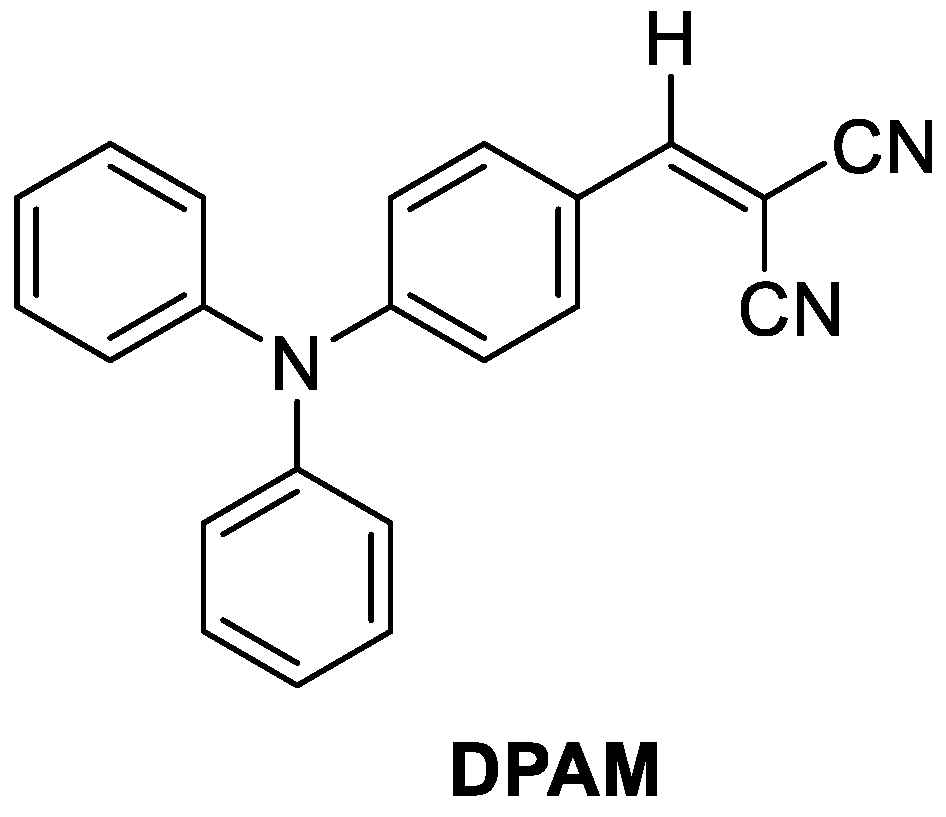
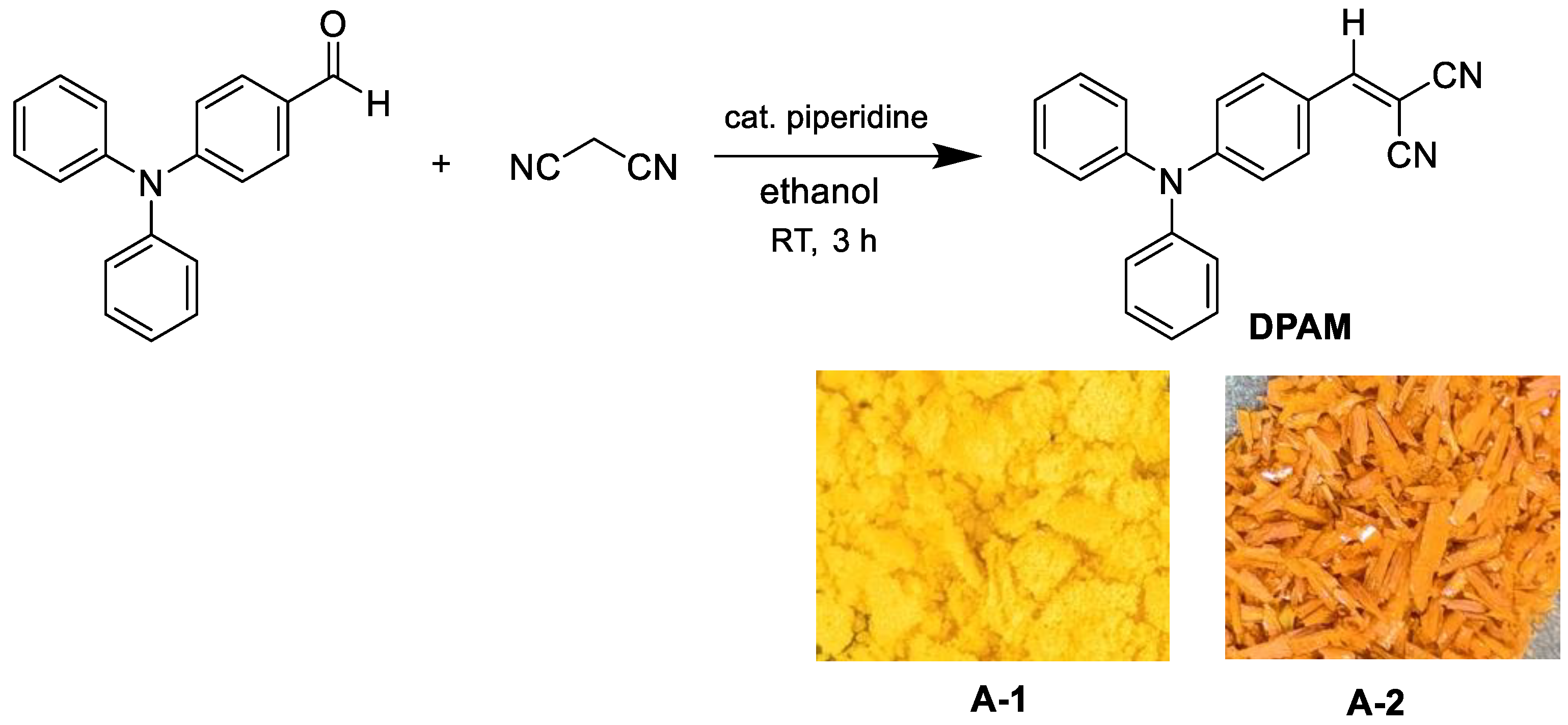

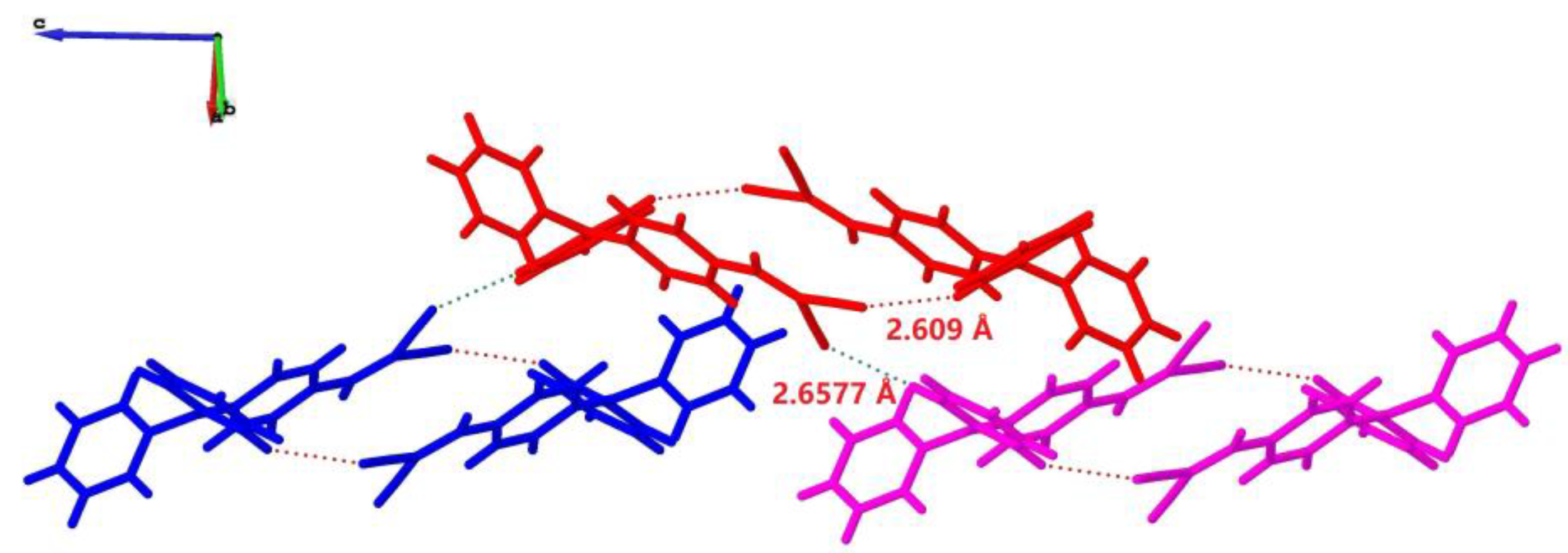

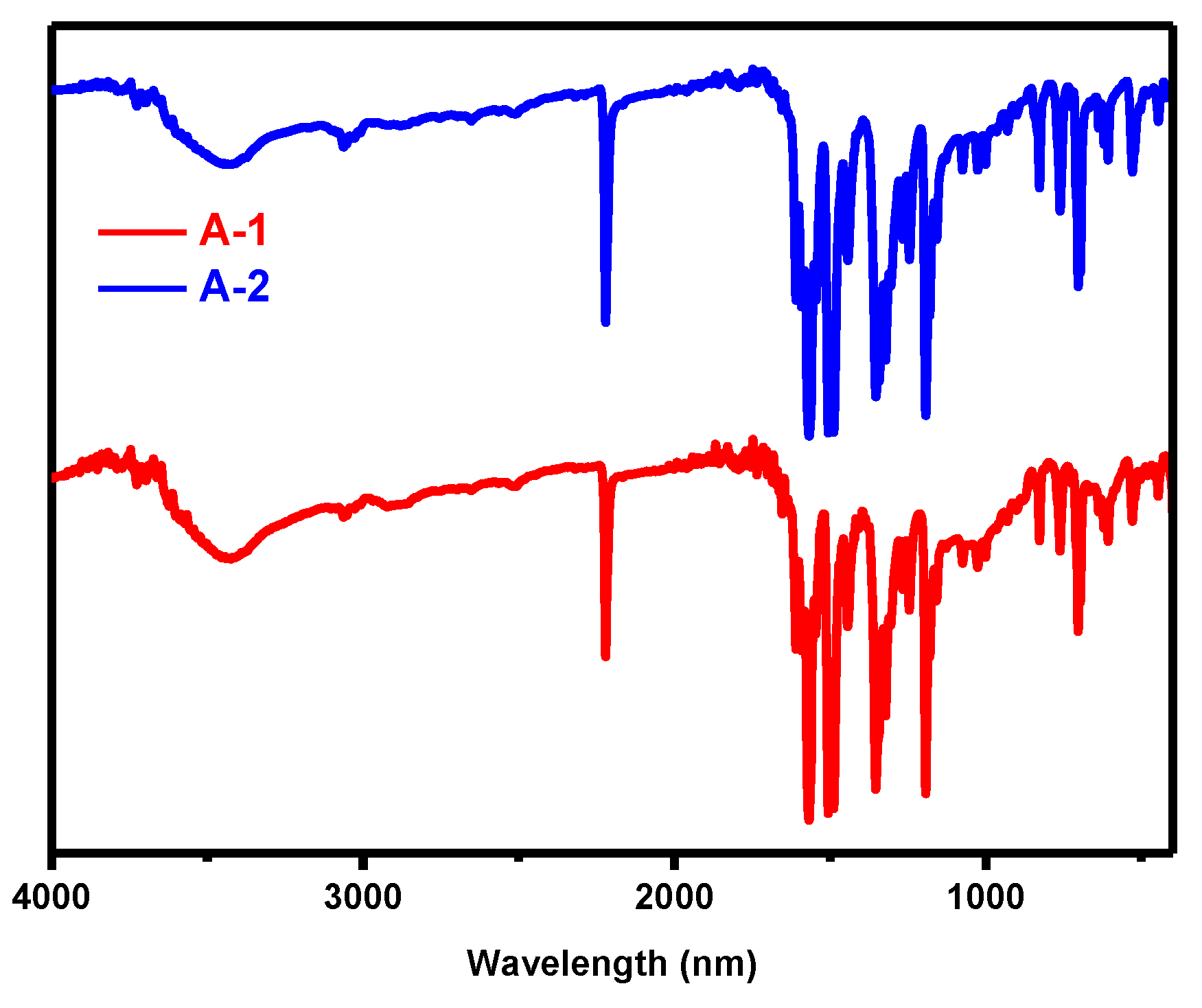
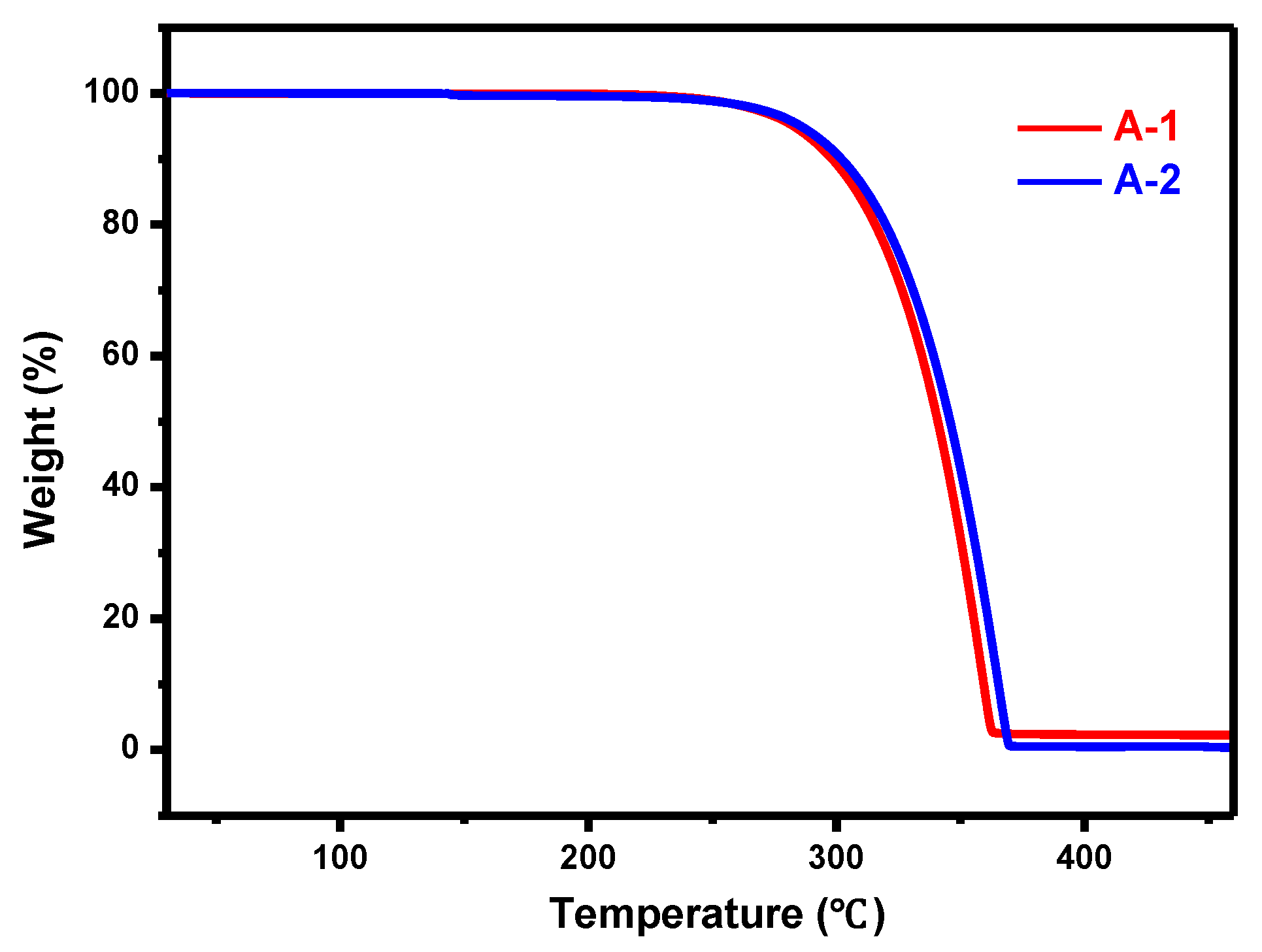




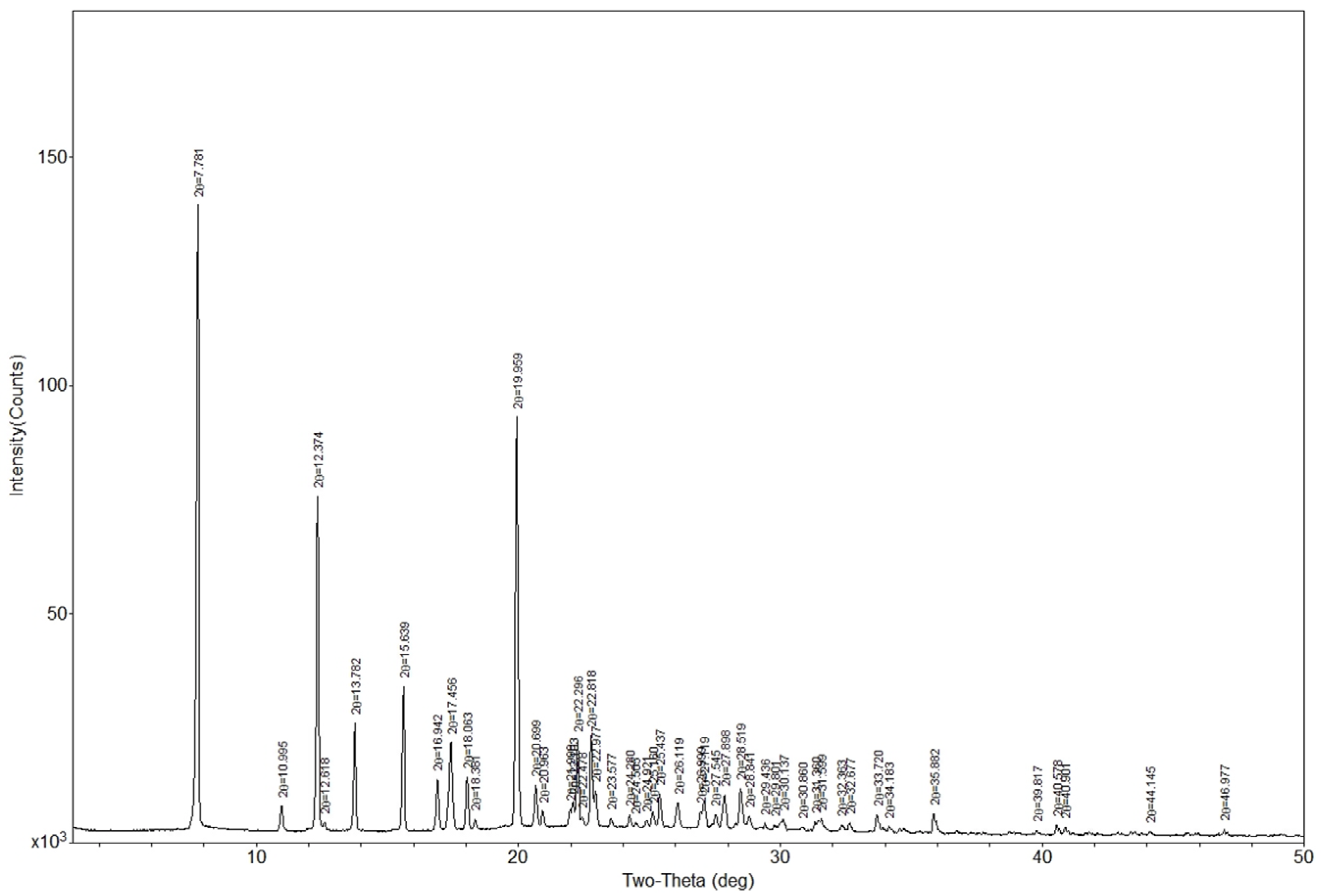
| Compound | A-1 | A-2 |
|---|---|---|
| Empirical formula | C22H15N3 | C22H15N3 |
| Formula weight | 321.37 | 321.37 |
| Temperature (K) | 170.0 | 302.00 |
| Crystal system | Orthorhombic | Monoclinic |
| Space group | Pbca | P21/c |
| a (Å) | 11.2205(6) | 7.0262(9) |
| b (Å) | 14.6394(10) | 15.9319(16) |
| c (Å) | 20.9226(16) | 16.1075(19) |
| α (°) | 90 | 90 |
| β (°) | 90 | 95.169(5) |
| γ (°) | 90 | 90 |
| Volume (Å3) | 3436.8(4) | 1795.8(4) |
| Z | 8 | 4 |
| ρcalc (g·cm−3) | 1.242 | 1.189 |
| μ (mm−1) | 0.075 | 0.072 |
| F(000) | 1344.0 | 672.0 |
| Crystal size (mm3) | 0.48 × 0.05 × 0.02 | 0.35 × 0.2 × 0.15 |
| Radiation | MoKα (λ = 0.71073) | MoKα (λ = 0.71073) |
| 2θ range for data collection (°) | 4.972 to 54.252 | 5.078 to 56.686 |
| Index ranges | −14 ≤ h ≤ 13, −18 ≤ k ≤ 17, −26 ≤ l ≤ 26 | −9 ≤ h ≤ 9, −21 ≤ k ≤ 21, −21 ≤ l ≤ 21 |
| Reflections collected | 23800 | 37280 |
| Independent reflections | 3802 (Rint = 0.0672, Rsigma = 0.0419) | 4468 (Rint = 0.0397, Rsigma = 0.0241) |
| Data/restraints/parameters | 3802/0/226 | 4468/0/226 |
| Goodness-of-fit on F2 | 1.058 | 1.163 |
| Final R indexes [I >= 2σ (I)] | R1 = 0.0434, wR2 = 0.0901 | R1 = 0.0888, wR2 = 0.2343 |
| Final R indexes [all data] | R1 = 0.0698, wR2 = 0.1058 | R1 = 0.1317, wR2 = 0.3143 |
| Largest diff. peak/hole (e.Å−3) | 0.13/−0.19 | 0.20/−0.30 |
| Bond/Distance (Å) | A-1 | A-2 |
|---|---|---|
| N1-C6 | 1.4370(18) | 1.435(3) |
| N1-C7 | 1.4335(17) | 1.438(3) |
| N1-C13 | 1.3885(18) | 1.375(3) |
| N2-C21 | 1.146(2) | 1.149(4) |
| N3-C22 | 1.150(2) | 1.148(4) |
| C1-C2 | 1.385(2) | 1.371(4) |
| C1-C6 | 1.388(2) | 1.379(4) |
| C2-C3 | 1.379(2) | 1.386(4) |
| C3-C4 | 1.378(2) | 1.360(6) |
| C4-C5 | 1.386(2) | 1.371(5) |
| C5-C6 | 1.381(2) | 1.380(5) |
| C7-C8 | 1.391(2) | 1.364(4) |
| C7-C12 | 1.389(2) | 1.379(4) |
| C8-C9 | 1.390(2) | 1.388(5) |
| C9-C10 | 1.384(2) | 1.366(5) |
| C10-C11 | 1.379(2) | 1.352(5) |
| C11-C12 | 1.386(2) | 1.387(4) |
| C13-C14 | 1.4099(19) | 1.408(3) |
| C13-C18 | 1.4071(19) | 1.401(3) |
| C14-C15 | 1.3751(19) | 1.370(3) |
| C15-C16 | 1.408(2) | 1.402(3) |
| C16-C17 | 1.402(2) | 1.405(3) |
| C16-C19 | 1.438(2) | 1.432(3) |
| C17-C18 | 1.373(2) | 1.369(3) |
| C19-C20 | 1.358(2) | 1.355(4) |
| C20-C21 | 1.438(2) | 1.423(4) |
| C20-C22 | 1.429(2) | 1.431(4) |
| Angles of A-1 (°) | A-1 | Angles of A-2 (°) | A-2 |
|---|---|---|---|
| C7-N1-C6 | 117.59(11) | C1-N1-C7 | 117.8(2) |
| C13-N1-C6 | 120.80(11) | C13-N1-C1 | 120.8(2) |
| C13-N1-C7 | 121.33(12) | C13-N1-C7 | 121.3(2) |
| C2-C1-C6 | 120.02(15) | C2-C1-N1 | 120.2(2) |
| C3-C2-C1 | 120.27(15) | C2-C1-C6 | 120.1(3) |
| C4-C3-C2 | 119.70(15) | C6-C1-N1 | 119.7(3) |
| C3-C4-C5 | 120.38(15) | C1-C2-C3 | 119.5(3) |
| C6-C5-C4 | 120.07(14) | C4-C3-C2 | 120.5(4) |
| C1-C6-N1 | 120.69(13) | C3-C4-C5 | 119.9(3) |
| C5-C6-N1 | 119.75(13) | C4-C5-C6 | 120.3(3) |
| C5-C6-C1 | 119.55(14) | C1-C6-C5 | 119.6(3) |
| C8-C7-N1 | 119.57(13) | C8-C7-N1 | 120.2(3) |
| C12-C7-N1 | 120.39(13) | C8-C7-C12 | 119.5(3) |
| C12-C7-C8 | 120.03(13) | C12-C7-N1 | 120.3(3) |
| C9-C8-C7 | 119.16(15) | C7-C8-C9 | 119.9(3) |
| C10-C9-C8 | 120.74(15) | C10-C9-C8 | 120.2(3) |
| C11-C10-C9 | 119.75(15) | C11-C10-C9 | 120.3(3) |
| C10-C11-C12 | 120.29(15) | C10-C11-C12 | 120.0(3) |
| C11-C12-C7 | 119.99(15) | C7-C12-C11 | 120.1(3) |
| N1-C13-C14 | 121.47(13) | N1-C13-C14 | 121.6(2) |
| N1-C13-C18 | 120.74(13) | N1-C13-C18 | 120.8(2) |
| C18-C13-C14 | 117.78(13) | C18-C13-C14 | 117.6(2) |
| C15-C14-C13 | 121.14(13) | C15-C14-C13 | 120.4(2) |
| C14-C15-C16 | 121.37(14) | C14-C15-C16 | 122.4(2) |
| C15-C16-C19 | 125.72(14) | C15-C16-C17 | 116.6(2) |
| C17-C16-C15 | 116.85(13) | C15-C16-C19 | 118.5(2) |
| C17-C16-C19 | 117.43(13) | C17-C16-C19 | 124.9(2) |
| C18-C17-C16 | 122.54(14) | C18-C17-C16 | 121.5(2) |
| C17-C18-C13 | 120.31(14) | C17-C18-C13 | 121.4(2) |
| C20-C19-C16 | 131.58(15) | C20-C19-C16 | 130.9(2) |
| C19-C20-C21 | 119.85(15) | C19-C20-C21 | 125.7(2) |
| C19-C20-C22 | 125.64(14) | C19-C20-C22 | 119.7(2) |
| C22-C20-C21 | 114.46(14) | C21-C20-C22 | 114.6(2) |
| N2-C21-C20 | 178.90(19) | N2-C21-C20 | 179.1(3) |
| N3-C22-C20 | 177.76(18) | N3-C22-C20 | 179.0(3) |
| Compounds | v (C-H) | v (C≡N) | v (C-H) |
|---|---|---|---|
| A-1 | 3052 | 2219 | 1487 |
| A-2 | 3060 | 2219 | 1486 |
| 2θ (°) | 1 | 2 | 3 | 4 | 5 |
|---|---|---|---|---|---|
| A-1 | 7.780 | 12.359 | 13.779 | 15.622 | 19.942 |
| A-2 | 7.820 | 12.382 | 13.815 | 15.633 | 19.983 |
Disclaimer/Publisher’s Note: The statements, opinions and data contained in all publications are solely those of the individual author(s) and contributor(s) and not of MDPI and/or the editor(s). MDPI and/or the editor(s) disclaim responsibility for any injury to people or property resulting from any ideas, methods, instructions or products referred to in the content. |
© 2025 by the authors. Licensee MDPI, Basel, Switzerland. This article is an open access article distributed under the terms and conditions of the Creative Commons Attribution (CC BY) license (https://creativecommons.org/licenses/by/4.0/).
Share and Cite
Gu, H.; Lin, Q. Crystal Form Diversity of 2-(4-(Diphenylamino)benzylidene) Malononitrile. Crystals 2025, 15, 380. https://doi.org/10.3390/cryst15040380
Gu H, Lin Q. Crystal Form Diversity of 2-(4-(Diphenylamino)benzylidene) Malononitrile. Crystals. 2025; 15(4):380. https://doi.org/10.3390/cryst15040380
Chicago/Turabian StyleGu, Haorui, and Qingwen Lin. 2025. "Crystal Form Diversity of 2-(4-(Diphenylamino)benzylidene) Malononitrile" Crystals 15, no. 4: 380. https://doi.org/10.3390/cryst15040380
APA StyleGu, H., & Lin, Q. (2025). Crystal Form Diversity of 2-(4-(Diphenylamino)benzylidene) Malononitrile. Crystals, 15(4), 380. https://doi.org/10.3390/cryst15040380






